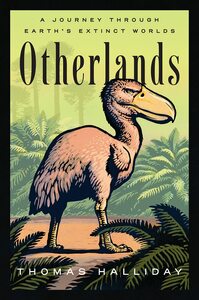Take a photo of a barcode or cover
informative
reflective
slow-paced
So detailed, you get a real feeling of what landscapes used to look like over the course of history. If you weren’t already, you definitely will be fascinated by the diversity of animals, plants and ecosystems that have inhabited the Earth after reading this book. It shows the beauty of biodiversity throughout millions of years, and confirms the need to put all our effort in conserving the species around us in the present day. I also really appreciated the maps attached to every chapter/time period, but would have liked more drawings of the mentioned species.
challenging
informative
slow-paced
Palaeontology is SO much more than Jurassic dinosaurs.
This took me forever to read but I loved every bit of it. Halliday's writing is beautiful.
This took me forever to read but I loved every bit of it. Halliday's writing is beautiful.
adventurous
informative
inspiring
adventurous
hopeful
informative
reflective
medium-paced
challenging
informative
inspiring
medium-paced
hopeful
informative
I wasn't sure how to rate this because it felt a bit bulky at times, but oh my GOD the social awareness sprinkled in throughout, and especially at the end. None of that "humans are eeeeeevuuuul" stuff. Turned a mostly positive, but at times bleh, read into something I will definitely remember. I think a few books I've read talk about how paleontology is useful for us to understand evolution and change, but I definitely think Otherlands is the clearest about it, big-picture-wise.
Put a corset on a springtail, tighten up the waist, and you would have a decent impression of an ant.
I laughed out loud when I read this, and this a book that is overflowing with such lyrical prose that is both charmingly absurd and impressively informative all at once. This is rare for a serious scientific book (and this is most definitely a serious scientific book). I found it to be immensely enjoyable as a result.
The book begins with the Pleistocene epoch some 20,000 years ago, with a chapter describing the Mammoth Steppe that ran from Alaska, across Eurasia, and extended all the way to modern Spain. It ends with the Ediacaran period some 550 million years ago, when the first multicellular life appeared on earth after a long period of intense glaciation (the Snowball Earth of the Cryogenian period).
It is a marvelous journey that is made all the more interesting by the author's primary device: He describes each epoch as a living, breathing period by describing the flora and fauna in detail, as though he were describing a foreign country. Filled with beautiful creatures and wild plants, he evokes a magical realm that is both extremely real and wonderfully alien. And he does this again and again in each chapter.
What's more, he travels further back in time with each chapter. This might be a little disconcerting at first, but the device grows on you. Each chapter sets the stage for the next by describing the descendants of the animals you are about to meet. It is like meeting a charming young boy first and meeting his parents the next day. This is a truly novel way of writing a paleontology book, and I was thoroughly impressed.
A word of caution though: I found that I could not read more than one or two chapters a day. I needed the time to digest the information and eke out a little understanding before I could pick the book up again. It took me two weeks to read the book as a result, but it was totally worth it.






